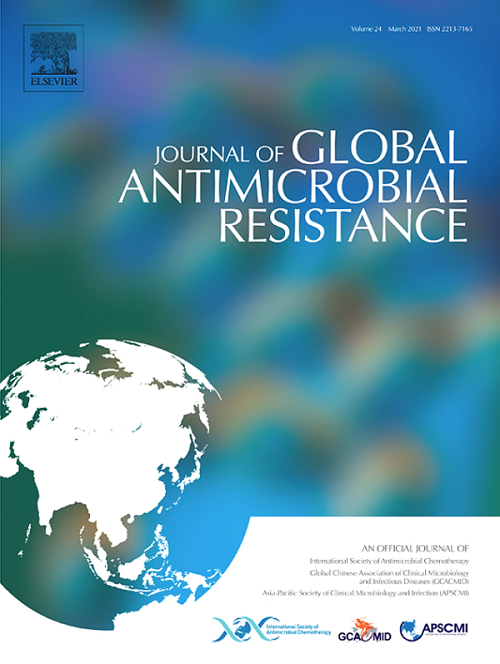Genomic characterisation of Pseudomonas asiatica as an emerging mastitis pathogen in dairy cows with resistance and virulence implications
IF 3.2
3区 医学
Q2 INFECTIOUS DISEASES
引用次数: 0
Abstract
Objective
Mastitis, a major concern in the dairy industry, is often caused by multidrug-resistant (MDR) pathogens, making treatment more challenging. This study aimed to elucidate the prevalence, antimicrobial resistance (AMR), antibiotic resistance genes (ARGs) and virulence genes (VGs) profiles of Pseudomonas asiatica strains isolated from milk, faeces, and farm soils of dairy cows diagnosed with clinical mastitis (CM).
Methods
Forty-five milk and 35 faeces samples from cows with CM, as well as 30 soil samples were collected from 30 small-holding dairy farms in Gazipur district, Bangladesh. P. asiatica was identified using culture-based methods, VITEK-2, and 16S rRNA sequencing. AMR profile was determined using disc diffusion method. Whole-genome sequencing (WGS) of four MDR P. asiatica isolates was performed for phylogenetic analysis, ARGs and VGs prediction.
Results
The overall prevalence of P. asiatica in the investigated dairy farms in this study was 37.27%, with rates of 29.27% in milk, 34.15% in faeces, and 36.59% in soil. All P. asiatica isolates were MDR, exhibiting highest resistance to imipenem, ampicillin, oxacillin, sulfonamides, nitrofurantoin, azithromycin, tetracycline, and cefoxitin. WGS revealed close phylogenetic ties between P. asiatica isolates (2M1, 2F1, 2F2, 2S1) and global Pseudomonas strains. Each of the four P. asiatica strains harbored 11 ARGs imparting resistance to multiple antibiotics, and 30 VGs linked to motility, alginate/pyoverdine synthesis, and regulatory systems.
Conclusions
This study identifies P. asiatica as an emerging MDR mastitis pathogen with significant environmental persistence. These findings highlight for species-specific diagnostics, and tailored antimicrobial strategies to improve mastitis control in dairy farming systems.
亚洲假单胞菌作为奶牛乳腺炎新发病原体的基因组特征及其耐药性和毒力意义。
背景:乳腺炎是乳制品行业的一个主要问题,通常是由多药耐药(MDR)病原体引起的,这使得治疗更具挑战性。本研究旨在研究从乳腺炎奶牛的乳汁、粪便和农场土壤中分离到的亚洲假单胞菌(Pseudomonas asiatica)的流行程度、耐药性(AMR)、抗生素耐药基因(ARGs)和毒力基因(VGs)谱。方法:从孟加拉国加济普尔地区的30个小型奶牛场采集CM奶牛的45份牛奶和35份粪便样本,以及30份土壤样本。采用基于培养的方法、VITEK-2和16S rRNA测序对亚洲假单胞菌进行鉴定。采用圆盘扩散法测定AMR谱。采用全基因组测序(WGS)对4株MDR亚洲单胞菌进行系统发育分析、ARGs和VGs预测。结果:本研究调查的奶牛场亚洲斑蝶总体患病率为37.27%,其中乳中患病率为29.27%,粪便中患病率为34.15%,土壤中患病率为36.59%。所有亚洲假单胞菌分离株均为耐多药,对亚胺培南、氨苄西林、恶西林、磺胺类药物、呋喃妥因、阿奇霉素、四环素和头孢西丁的耐药性最高。WGS结果显示,亚洲假单胞菌分离株(2M1、2F1、2F2、2S1)与全球假单胞菌具有密切的系统发育关系。4株亚洲单胞假单胞菌均含有11个对多种抗生素产生耐药性的ARGs,以及30个与运动、海藻酸盐/吡啶合成和调控系统相关的VGs。结论:本研究确定亚洲假单抗是一种新兴的耐多药乳腺炎病原体,具有显著的环境持久性。这些发现强调了针对特定物种的诊断和量身定制的抗菌策略,以改善奶牛养殖系统中的乳腺炎控制。
本文章由计算机程序翻译,如有差异,请以英文原文为准。
求助全文
约1分钟内获得全文
求助全文
来源期刊

Journal of global antimicrobial resistance
INFECTIOUS DISEASES-PHARMACOLOGY & PHARMACY
CiteScore
8.70
自引率
2.20%
发文量
285
审稿时长
34 weeks
期刊介绍:
The Journal of Global Antimicrobial Resistance (JGAR) is a quarterly online journal run by an international Editorial Board that focuses on the global spread of antibiotic-resistant microbes.
JGAR is a dedicated journal for all professionals working in research, health care, the environment and animal infection control, aiming to track the resistance threat worldwide and provides a single voice devoted to antimicrobial resistance (AMR).
Featuring peer-reviewed and up to date research articles, reviews, short notes and hot topics JGAR covers the key topics related to antibacterial, antiviral, antifungal and antiparasitic resistance.
 求助内容:
求助内容: 应助结果提醒方式:
应助结果提醒方式:


